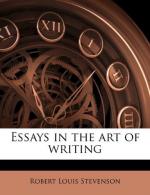This odd suicide of one branch of the realists may serve to remind us of the fact which underlies a very dusty conflict of the critics. All representative art, which can be said to live, is both realistic and ideal; and the realism about which we quarrel is a matter purely of externals. It is no especial cultus of nature and veracity, but a mere whim of veering fashion, that has made us turn our back upon the larger, more various, and more romantic art of yore. A photographic exactitude in dialogue is now the exclusive fashion; but even in the ablest hands it tells us no more—I think it even tells us less—than Moliere, wielding his artificial medium, has told to us and to all time of Alceste or Orgon, Dorine or Chrysale. The historical novel is forgotten. Yet truth to the conditions of man’s nature and the conditions of man’s life, the truth of literary art, is free of the ages. It may be told us in a carpet comedy, in a novel of adventure, or a fairy tale. The scene may be pitched in London, on the sea-coast of Bohemia, or away on the mountains of Beulah. And by an odd and luminous accident, if there is any page of literature calculated to awake the envy of M. Zola, it must be that Troilus and Cressida which Shakespeare, in a spasm of unmanly anger with the world, grafted on the heroic story of the siege of Troy.
This question of realism, let it then be clearly understood, regards not in the least degree the fundamental truth, but only the technical method, of a work of art. Be as ideal or as abstract as you please, you will be none the less veracious; but if you be weak, you run the risk of being tedious and inexpressive; and if you be very strong and honest, you may chance upon a masterpiece.
A work of art is first cloudily conceived in the mind; during the period of gestation it stands more clearly forward from these swaddling mists, puts on expressive lineaments, and becomes at length that most faultless, but also, alas! that incommunicable product of the human mind, a perfected design. On the approach to execution all is changed. The artist must now step down, don his working clothes, and become the artisan. He now resolutely commits his airy conception, his delicate Ariel, to the touch of matter; he must decide, almost in a breath, the scale, the style, the spirit, and the particularity of execution of his whole design.
The engendering idea of some works is stylistic; a technical preoccupation stands them instead of some robuster principle of life. And with these the execution is but play; for the stylistic problem is resolved beforehand, and all large originality of treatment wilfully foregone. Such are the verses, intricately designed, which we have learnt to admire, with a certain smiling admiration, at the hands of Mr. Lang and Mr. Dobson; such, too, are those canvases where dexterity or even breadth of plastic style takes the place of pictorial nobility of design. So,




